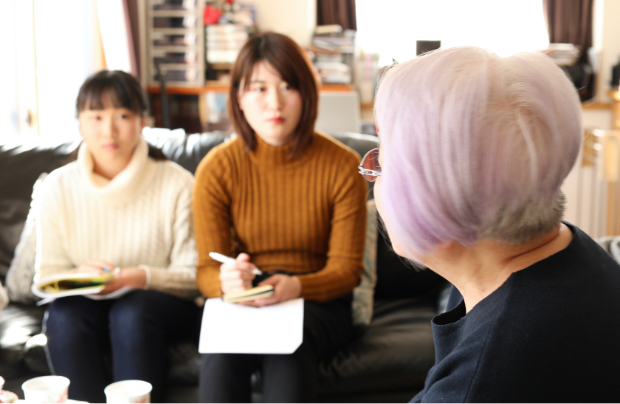HIROSHIMA memory keepers Succeed to history
Vol. 17 2021.3.22 up
We put much emphasis on asking the participants questions and having a dialogue, rather than conveying information to them one-sidedly.
Haruki Yamaguchi
Peace Education Director, Education Division, Peace Culture Village (NPO)
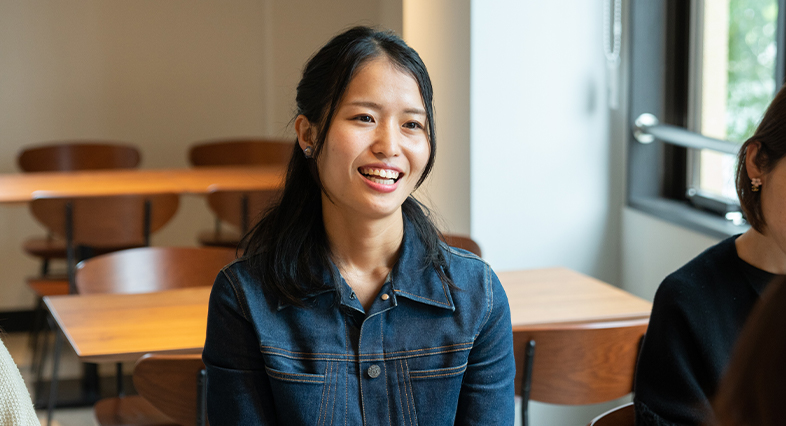
What do people handing down the experience of the A-bombing think and try to convey?
In July, 2020, the Hiroshima Peace Memorial Park Rest House reopened after renovation work. In the Rest House, Haruki Yamaguchi, 27, is planning and conducting programs, such as PEACE PARK TOUR@REST HOUSE, a guided tour of the Peace Memorial Park, and PEACE DIALOGE, a peace education program for junior and senior high school students.
Section
How Ms. Yamaguchi got involved in peace activities
Tell us how you got involved in the peace activities that you are doing now.
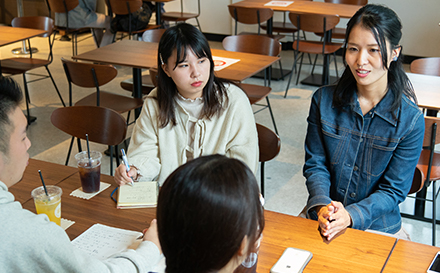
At that time, I was also an English-speaking tour guide of MagicalTrip, Inc., a tour company, showing inbound tourists around Peace Memorial Park and Miyajima several times a month.
One day, the PCV member who knew my background invited me, saying, “We are going to conduct Peace Memorial Park tours every day at the Rest House, which is now being renovated and scheduled to reopen in July next year (in 2020.) Would you like to join us?”
Were you interested in peace activities before that?
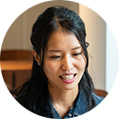
I was born and raised here in Hiroshima, where we have peace education programs from elementary school; however,our compulsory lessons about the horrors of the atomic bombing terrified me. I think I set up a mental barrier against it.
As a college student, I traveled overseas by myself and stayed in Vancouver, Canada for a year. Whenever I said that I was from Hiroshima, people asked me questions about the A-bombing, such as “Is Hiroshima all right now?” “Is there still any residual radioactivity?”
At that time, I wasn’t able to tell them what had happened in Hiroshima and the city’s history at all, even though it is my hometown. Because of that regret, I determined to learn about the A-bombing on Hiroshima and become able to talk about it in English. But I gave up on the way because it was such a serious and complex topic for me.
After you had given up when you were a college student, when did you restart learning about the A-bombing on Hiroshima?

One year after my graduation, I registered as a Hiroshima International Youth Volunteer of JMS Aster Plaza and attended its programs, such as cross-cultural communication and guiding around Peace Memorial Park in English. Then, I applied to be a Japanese to English volunteer interpreter for the August 6th tour.
While being trained to be a volunteer interpreter, I had a strong desire to tell more to people from other countries about the A-bombing, in my own words, not as an interpreter.
After that, I had a chance and became a tour guide of MagicalTrip, Inc.
My first motive for peace activities was to talk about the A-bombing on Hiroshima in English, but now I want to offer people an opportunity to make a personal connection with what happened in Hiroshima.
About Ms. Yamaguchi’s Activities
Tell us about your tour PEACE PARK TOUR@REST HOUSE.
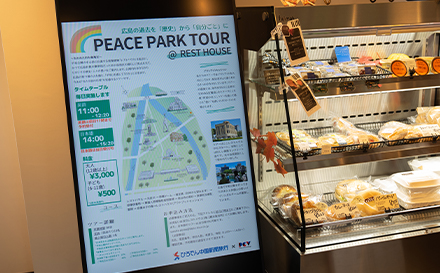
Beginning at the Rest House, an A-bombed building in the center of Peace Memorial Park, our tour focuses on the lost community of Nakajima district, which used to be one of the busiest areas of Hiroshima City.
The tour is run by a bilingual team of Japanese, American and British guides. The main members of the team are in their twenties, and we guide both in Japanese and English.

Do you have anything you want to convey in the tour?
Before starting, I ask participants why they take our tour. To the ones who have already learned about the A-bombing on Hiroshima, I try to give them new information and views. And to the ones who have never visited here before, I am careful not to give too much information and always try to guide them in simple language, hoping my guiding would make them realize something for themselves.
Why are you careful not to give too much information when you guide first-time visitors?
Considering what I should tell them within the limited time, I think that it is more important for them to have opportunities to think for themselves and talk about what they think and feel, rather than just to listen to me.According to the “active learning method,” students retain 5% of the lecture they hear, 50% when they discuss, 75% when they practice and 90 % when they teach others. We hope that the participants will take what happened in Hiroshima as their own concern. So we put more emphasis on asking them questions and having a dialogue with them rather than conveying information to them one-sidedly.
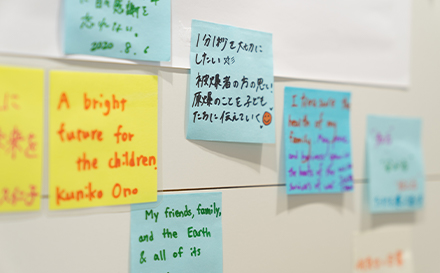
What kinds of questions do you ask the participants? Would you be more specific?
We ask them many different questions during the tour, and we have three major moments of Reflection Time.
In one of those Reflections, we ask participants to imagine what happened to people in Nakajima district on the morning of the A-bombing by comparing that to one morning from their own lives.
At the end of the tour, we take an Output Time, in which participants think back on what they experienced during the tour. We ask them, “Among the places you visited and the stories the guide told you today,what had the biggest impact on you?” and “How do you feel about Hiroshima now?” Then, we ask them about what they treasure in their lives.
We received many comments from participants, saying that the Reflections and Output were the most meaningful part of the tour.
Along with the tour, you have a program for elementary, junior and senior high school students called PEACE DIALOGUE. Please tell us more about it.
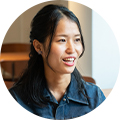
PEACE DIALOGUE is a peace education program for students visiting Hiroshima Peace Memorial Park on school trips. The students have an opportunity to think about peace independently on their own through dialogues with local young peace activists in their teens and twenties.
We have more programs, such as school visits for learning through discussion, online learning sessions, live-streamed tours of Peace Memorial Park, and survivors’ testimony sessions. These programs are customized every time.
The important thing in any program is that we don’t give the students an answer but ask questions so that they can think on their own freely.
Over 2,000 students attended our programs in the six months after we launched our Rest House in July, 2020. We want to set up more programs.
In the tours, what do you feel the most satisfaction about?
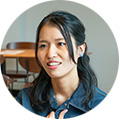
When I hear participants’ comments after the tour. Although we take the same course, the content of our talk changes depending on the participants. And different comments come. I myself have a new discovery every time.
A participant from overseas said to me, “I was really ignorant about Hiroshima. Thank you very much,” and a high school student said, “Working for peace is cool.” When I get such comments, I am very happy.
If the tour participants have a good time with me, they will leave Hiroshima with good memories. As their guide, I be part of the image of Hiroshima that they remember. I am very glad to have such a job.
About your approach to young people
Your activities are targeting those who are relatively highly conscious of and concerned with peace education. What approach do you have toward those who are less concerned, especially young people?
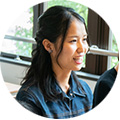
We are posting messages on Instagram and other social media, and using the latest technology, such as VR and AR, so that hopefully more people will be interested in peace issues.
I think that many people who grow up in Hiroshima are traumatized by learning about the horrors of nuclear weapons in school. So I hope more and more people will have PEACE DIALOGUE, our new style of peace education.
What do you think is necessary for the younger generation to continue their peace activities?

There are a certain number of young people who want to get involved with peace activities, and most of them are doing it as volunteers. I suppose many of those young people quit these activities after graduating from university because they cannot earn a living by such volunteer activities.
Our tours charge \3,000 for adults. It is a new style of peace activity, because guides are paid, not volunteers, and the tour is available every day even without a reservation.
In the long term, I hope jobs associated with peace can be recognized as an industry. If this happens, more young people would continue their peace activities.
I want PCV to be a successful case model for that.
Ms. Yamaguchi’s goal for the future and messages to the younger generation
You are expecting younger generations to join your peace activities. Do you mean people outside Hiroshima as well?

Yes, I do. Now, our main members are living in Hiroshima, but I want more to join us, regardless of where they live. We won’t set any criteria for whom we welcome to our activities, like whether they live in Hiroshima or whether they are a third-generation A-bomb survivor.
We will welcome whoever wants to join our activities, even if they are from outside Hiroshima Prefecture or even from overseas.
I think that anybody should have his or her own words and ways of guiding, learned from their own experiences. I want them to do our programs making good use of their own personality.
Tell us about PCV’s goals and visions for the future?

This year, we will establish an online school, PEACE CULTURE ACADEMY (PCA), where each participant thinks about how they want to live and how they want to pursue peace culture..
PCV considers this online school significant as a platform for young peace activists around the country not only to get together and learn by input, but also to present their thoughts by output and practice by themselves.
I myself want to know other cities’ history and people’s thoughts more, so I hope that in this online school, participants including me will exchange information and learn from each other.
Ultimately, I hope that this online school will be a global platform to share information and to communicate with each other.
Last, what message would you like to give to the people in your same generation?
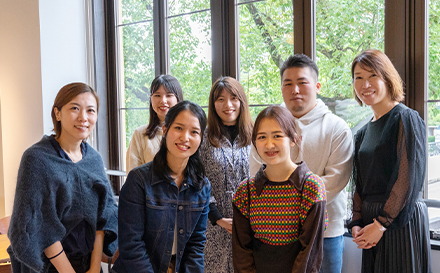
My grandfather was an A-bomb survivor, so I am a third-generation A-bomb survivor. Now I really want to listen to his experience, but unfortunately, he had already died when I started to have an interest in peace activities.
I would not be here without my grandfather. What happened to him and to Hiroshima 75 years ago is not a distant past event. It has led to what I am now.
Not only Hiroshima, but also many other places around Japan, such as Nagasaki, Okinawa and Kagoshima, were damaged in the war. That is why I want my generation to have an opportunity to have a dialogue with their grandfathers and grandmothers.
How about beginning the dialogue with a question, asking, “What kind of life did you have in those days?” or “What kind of food did you eat?” Then the conversation would progress with further questions, such as, “What did you like to do when you were in secondary school?” “What was it like during the air attack?” “Did you have any dreams?” You may hear unexpected stories.
The war our grandfathers and grandmothers went through is not distant past, but is still relevant to our lives today.
I think my being away from Japan helped me see Hiroshima and Japan, where I was born, from the outside and I learned a lot from that perspective.
I strongly recommend that, if they haven’t been abroad, young people go out of Japan. I am sure they will have their thoughts deepened or changed and have a new discovery.
Along with other people in my generation, I will keep thinking about what we can do.
Interviewed on October 2020.
About
"Interviews with HIROSHIMA memory keepers" is a part of project that Hiroshima「」– 3rd Generation Exhibition: Succeeding to History
We have recorded interviews with A-bomb survivors, A-bomb Legacy Successors, and peace volunteers since 2015.
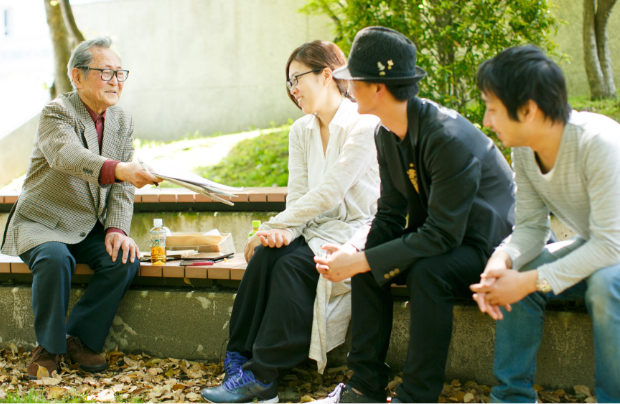
What are Hiroshima memory keepers feeling now, and what are they trying to pass on?
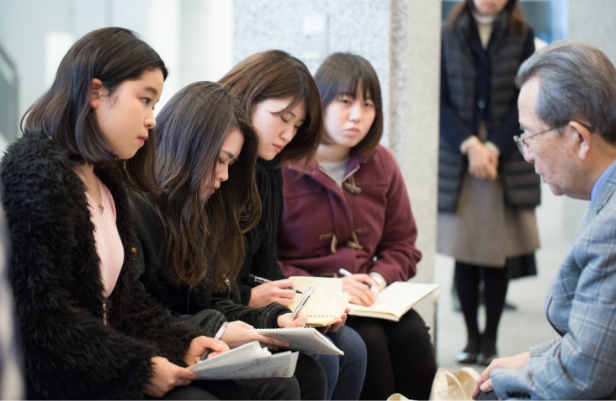
What can we learn from the bombing of Hiroshima? What messages can we convey to the next generation? Please share your ideas.
